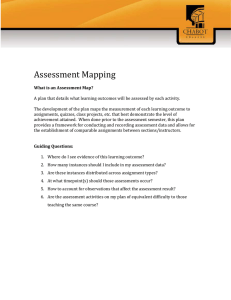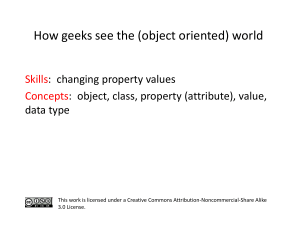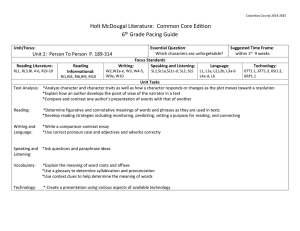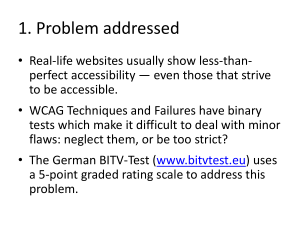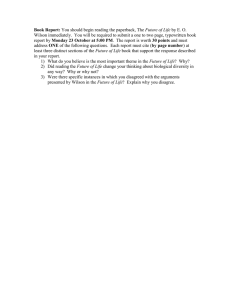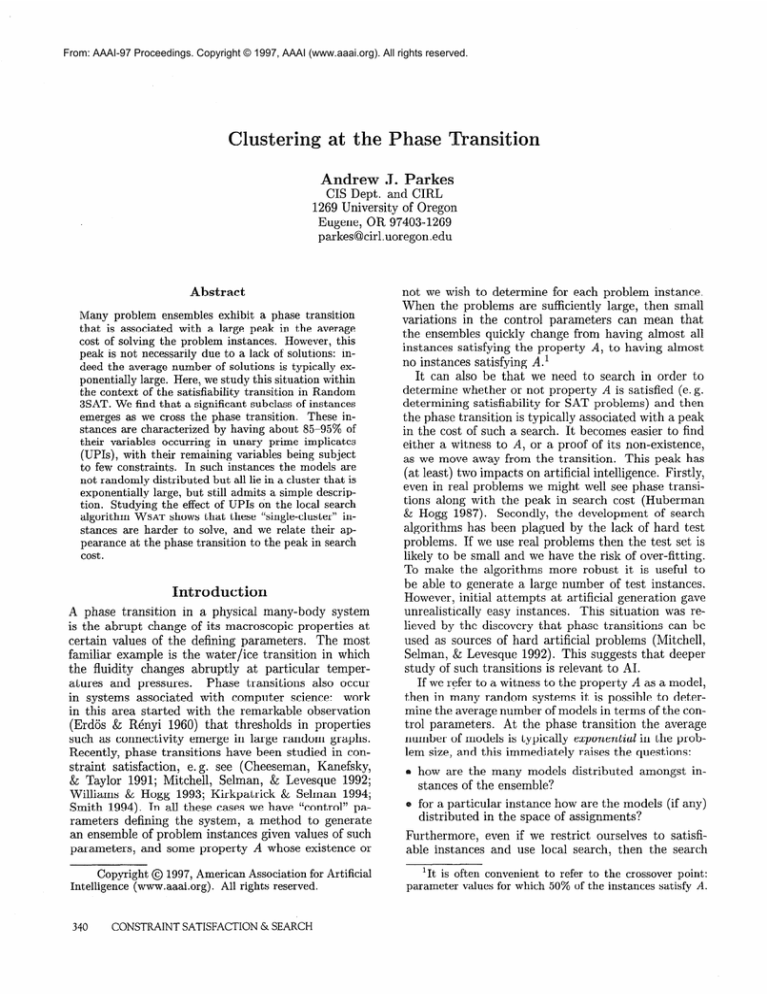
From: AAAI-97 Proceedings. Copyright © 1997, AAAI (www.aaai.org). All rights reserved.
Clustering
at the Phase
Andrew
ansit ion
J. Pa&es
CIS Dept. and CIRL
1269 University
of Oregon
Eugene, OR 97403-1269
parkes@cirl.uoregon.edu
Abstract
Many problem ensembles exhibit a phase transition
that is associated with a large peak in the average
cost of solving the problem instances. However, this
peak is not necessarily due to a lack of solutions: indeed the average number of solutions is typically exponentially
large. Here, we study this situation within
the context of the satisfiability
transition
in Random
SSAT. We find that a significant subclass of instances
emerges as we cross the phase transition.
These instances are characterized
by having about 85-95% of
their variables occurring
in unary prime implicates
(UPIs), with their remaining
variables being subject
to few constraints.
In such instances the models are
not randomly distributed
but all lie in a cluster that is
exponentially
large, but still admits a simple description. Studying the effect of UPIs on the local search
algorithm
WSAT shows that these “single-cluster”
instances are harder to solve, and we relate their appearance at the phase transition
to the peak in search
cost.
Introduction
A phase transition
in a physical
many-body
system
is the abrupt
change of its macroscopic
properties
at
certain
values of the defining
parameters.
The most
familiar
example
is the water/ice
transition
in which
the fluidity
changes
abruptly
at particular
temperatures and pressures.
Phase transitions
also occur
in systems associated
with computer
science:
work
in this area started with the remarkable
observation
(Erdos
& Renyi 1960) that thresholds
in properties
such as connectivity
emerge in large random
graphs.
Recently,
phase transitions
have been studied in constraint
satisfaction,
e. g. see (Cheeseman,
Kanefsky,
& Taylor
1991; Mitchell,
Selman,
& Levesque
1992;
Williams
& Hogg 1993; Kirkpatrick
& Selman
1994;
Smith 1994). In all these cases we have “control”
parameters
defining
the system, a method
to generate
an ensemble of problem
instances given values of such
parameters,
and some property
A whose existence or
Copyright @ 1997, American Association for Artificial
Intelligence
(www.aaai.org).
All rights reserved.
340
CONSTRAINT SATISFACTION
& SEARCH
not we wish to determine
for each problem
instance.
When the problems
are sufficiently
large, then small
variations
in the control
parameters
can mean that
the ensembles quickly
change from having almost all
instances satisfying
the property
A, to having almost
no instances satisfying
A.l
It can also be that we need to search in order to
determine
whether or not property
A is satisfied (e. g.
determining
satisfiability
for SAT problems)
and then
the phase transition
is typically
associated
with a peak
in the cost of such a search. It becomes easier to find
either a witness to A, or a proof of its non-existence,
as we move away from the transition.
This peak has
(at least) two impacts on artificial
intelligence.
Firstly,
even in real problems
we might well see phase transitions along with the peak in search cost (Huberman
& Hogg 1987).
Secondly,
the development
of search
algorithms
has been plagued by the lack of hard test
problems.
If we use real problems
then the test set is
likely to be small and we have the risk of over-fitting.
To make the algorithms
more robust
it is useful to
be able to generate
a large number
of test instances.
However,
initial
attempts
at artificial
generation
gave
unrealistically
easy instances.
This situation
was relieved by the discovery
that phase transitions
can be
used as sources of hard artificial
problems
(Mitchell,
Selman, & Levesque 1992). This suggests that deeper
study of such transitions
is relevant to AI.
If we refer to a witness to the property
A as a model,
then in many random
systems it is possible to determine the average number of models in terms of the control parameters.
At the phase transition
the average
number of models is typically
exponential
in the problem size, and this immediately
raises the questions:
Q how are the many models
stances of the ensemble?
distributed
amongst
o for a particular
instance how are the models
distributed
in the space of assignments?
Furthermore,
able instances
even if we restrict
ourselves
and use local search, then
in-
(if any)
to satisfithe search
‘It is often convenient to refer to the crossover point:
parameter values for which 50% of the instances satisfy A.
cost still seems to peak at the phase transition
(Hogg
& Williams
1994; Clark et al. 1996).
This is somewhat counter-intuitive
because the average number
of
models per instance does not peak (or even seem to be
special in any way), yet we might well expect that the
search cost is related to numbers of models.
In this paper we study such issues in the context
of the well-studied
satisfiability
transition
in Random
3SAT (Kirkpatrick
& Selman 1994; Crawford
& Auton
1996; Schrag & Crawford
1996). Our aim is to provide
a finer description
of the transition
than the coarse
description
as a boundary
between satisfiable
and unsatisfiable
phases. However, the exponential
number of
models also makes it difficult
to study them directly.
Instead we work indirectly
by looking at the implicates
of the theory and in particular
at the distributions
associated with the unary prime implicates2
(UPIs).
Our
main result is that there is indeed a finer structure
observable in the UPI-distributions.
As we cross into the
unsatisfiable
phase then there emerges a large distinct
subclass of instances.
The models in these instances
are not randomly
distributed,
but all lie in a single
exponentially
large cluster,
which moreover
admits a
short and simple description.
These “single cluster instances” are harder to solve by local search, and their
emergence
at the phase transition
seems to be linked
to the peak in search cost.
By Random
3SAT we mean the uniform
fixed-length
clause distribution
(Mitchell,
Selman,
& Levesque
1992). Ensembles
are parameterized
by (n, c) where n
is the total number of variables,
and c is the number of
clauses. The c clauses are generated
independently
by
randomly
picking
3 variables
and negating
each variable with probability
of 50%. The clause/variable
ratio, a = c/n, is used as the control parameter.
There are 2n possible variable
assignments,
and any
one clause is consistent
with 7/8 of these. The average
number
of models,
M, per problem
instance
is then
(e.g. (Williams
& Hogg 1993))
M = 2n
7 c
0s
241
- a/5.19)
=
Any region with M < 1 must contain unsatisfiable
instances, so assuming
the existence
of a satisfiability
phase transition
forces it to occur at Q 5 5.19. Experiments
show that the phase transition
actually
occurs at Q! M 4.26 (Crawford
& Auton
1996) giving an
average of 2°.18n models per instance.
There are arguments
that come quite close to this empirical
value
(Williams
& Hogg 1993; Smith 1994), but so far there is
2An implicate
is entailed
by the theory.
A prime
impli-
cate is one that
is not subsumed
by another
implicate.
A
unary
implicate
is just a literal.
A binary
implicate,
for our
purposes,
is a disjunction
of two literals,
i.e.
a clause
of
length
two.
1000
800
600
400
200
0
0
20
40
60
80
100 120
UPIS, u
140
160
180
200
Figure 1: Histogram
giving the numbers
of instances
having u UPIs as a function
of u. Obtained
from lo5
satisfiable
instances at (n,c)=(200,854).
no derivation
of the exact transition
point. In contrast,
for random
2SAT the position
of the phase transition
is known exactly, but is not so interesting
because satisfiability
is then in P. Actually,
there appears to be an
intriguing
link between exact results and the complexity class of the decision problem
in that exact results
are associated
with P. The link is often direct, as for
2SAT, but might also be indirect,
e.g. the threshold
for the existence of Hamiltonian
cycles (which is NPcomplete)
is known exactly in random
graphs.
However, this threshold
“piggy-backs”
the transition
for
2-connectedness,
which is in P. As soon as the graph
is 2-connected
then it almost surely has a Hamiltonian
cycle (Bollobas
1985). I am not aware of exact threshold results not of one of these types.
To remove unsatisfiable
instances
from the ensemble, and also to find the prime
implicates
we used
NTAB,
a variant of TABLEAU, (Crawford
& Auton 1996;
Schrag & Crawford
1996).
Such systematic
searches
are computationally
expensive
and provide
the main
limit on the range of accessible values of n. Once we
have the UPIs for an instance then we can also generate the “residual”
theory. This is a mixed 2SAT/3SAT
theory over all the residual,
or free, variables
(those
variables
not contained
in UPIs). The residual
clauses
are obtained
by using the UPIs to simplify
each of the
original
clauses.
If an instance
has u UPIs then the
residual
theory has f = n - u residual
variables,
and,
by definition,
must be satisfiable
and have no UPIs
itself.
Since some of the fastest known algorithms
are local search algorithms
we also study the performance
of
WSAT (Selman,
Kautz, & Cohen 1994) on the satisfiable instances.
esults
for
adorn
3SAT
In this section we study the “UP1-distribution”
as a
function
of (n, c). After generating
instances,
we remove those that are unsatisfiable,
and for each of the
others we find the number of UPIs, u, that it possesses.
STRIJCTUREOFCONSTRAINT
SATISFACTIONPROBLEMS
341
,,,
400
I
300
(200,826).
84% Sat -
200
100
0
0
400
20
40
60
80
100
120
140
160
180
200
,I
(200,854).
49% Sat ~
200
100
0
0
0
20
40
60
80
100
120
140
160
180
200
(200,890).
11% Sat -
200
100
0
0
100
120
140
160
180
Counting the number of instances that occur in given
ranges of u gives the desired distribution.
Figure 1 gives the UPI-distribution
found close to
the crossover point for n = 200. Figure 2 gives a sample of the results obtained from a “slice” through the
phase transition, i.e. varying c at fixed n.
At small c most instances have few UPIs, but the
average number of UPIs increases dramatically as we
increase c. A peak emerges in the region 170 < u <
190, and for reasons to be explained later we will call
this the “single cluster peak”. Conversely, the region
120 < u < 170 remains consistently underpopulated.
Perhaps, figure 2 might best be described as a “sloshing
of the UPIs” .
We should check that this pattern persists as we increase n, and for this we use the UP1 density u/n.
Figure 3 shows the effect of increasing n while remaining at the crossover. The distribution pattern seems to
persist (except for smaller values of u/n, with which
we will not be concerned here). In particular, the position (and indeed existence) of the single-cluster peak
is stable at u/n z 0.9.
of the
UP1
slosh
In random graph theory it can be helpful to study the
evolution of ensemble properties as we add more edges
(Bollobas 1985). H ere we make some simple arguments
in order to study the evolution of the UPI-distribution
as we add more clauses. In particular, we propose a
partial explanation of the “slosh” of the UPIs as observed in figure 2.
342
CONSTRAINT
SATISFACTION
30
40 50 60
u/n * 100%
70
80
90
lb0
200
Figure 2: Histograms of the UPI-distribution
obtained
while traversing the phase transition with n fixed at
200. The legend “x% Sat” means that, at the given
(n,c) values, x% of the total ensemble is satisfiable.
Each histogram is derived from 5000 satisfiable instances.
Interpretation
20
Figure 3: Histogram of UPI-distributions.
Here the xaxis is percentage UPIs. The y-axis is the frequency of
instances normalized so that a flat distribution would
give 1. The (n, c) values are chosen to remain at the
crossover point as we increase n.
-TV”
300
10
& SEARCH
Consider the addition of a single new and randomly
selected clause to an existing instance. We want to find
the number of new UPIs created as a result of this new
clause, and in particular to find how the number of new
UPIs varies as a function of the numbers of UPIs and
number of binary prime implicates (BPIs) b already
present in the instance. We will use figure 4 in order
to illustrate the arguments for the crossover point at
n=lOO. It is convenient to define X = f/n E (1 - u/n).
Since the new clause is independent of the existing
UPIs we have that each literal of the new clause remains free with probability X, otherwise the UPIs force
it true with probability (1 - X)/2 or false with probability (1 - X)/2. It is then straightforward
to find
the probabilities of the various fates of the new clause
under the existing UPIs. For example, there is a probability of ((1 - X)/2)” that all three literals of the new
clause are forced to false rendering the theory unsatisfiable. We must exclude this case (as we only consider
satisfiable instances) and then the probability of the
new clause reducing to a unary clause, and so directly
giving rise to a new UP1 is
Prob(Unit
Clause) = P(X) =
3xp-$>'L
1 - $(l - X)3
(2)
An example of this function is given in figure 4c.
However, if we happen to create a new UPI then it
can give rise to more UPIs by resolution against the b
BPIs already present in the theory. Again, since the
new clause (and hence initial new UPI) was independent of the existing BPIs it follows that the expected
number of BPIs that contain the negation of the new
UP1 is just (2b)/(2f).
S o, after a single pass through
the BPIs, we will have a total of (1 + b/f)P(X) new
UPIs. An example is given in figure 4d based on the
empirical data for b.
These latest UPIs can again propagate to cause even
more UPIs, but further calculation is hampered by the
12
11
10
9
8
7
6
5
4
3
2
1
0
0
10 20 30 40 50 60 70 80 90 100
UPIS
Figure 4: For a sample of lo* satisfiable instances at
(100,430) we g ive, as a function of the number of UPIs:
(a) the empirical (normalized) frequency of that number of UPIs, (b) the empirical average number of BPIs
per free variable, (c) P(X), an estimate of the number
of new UPIs directly created from one new clause. (d)
as for (c) but also including the effect of propagating
the new UPIs once through the BPIs.
fact that the latest UPIs need not be be independent
of the existing theory. Even with this crude approximation we see from figure 4d that that the effect of a
new clause is smallest when u is close to either 0 or n,
and largest in the middle of the range.
This allows us to build a picture of the typical evolution of an instance starting in the underconstrained
region and adding new clauses while ensuring that the
theory does not become unsatisfiable. Being initially
underconstrained the instance will start with a small
value of u. At first the growth of u will be slow because of the small chance of new clauses generating new
UPIs, however once u starts to grow then the peak observed in figure 4d suggests that the growth of u will
be rapid until u reaches u M 0.8n.At this point growth
of u will again slow down. This provides a reasonable
“first-order” explanation of the deficit of instances in
the middle and the accumulation of instances into the
single-cluster peak.
Clusters
We now look at the nature of instances in the peak observed in the UP1 distribution at u/n M 0.9.The most
important property we find is that for instances in the
peak, the residual theories (after imposing the UPIs)
are very underconstrained, with few clauses per residual variable. This is supported by figure 4b - in the region u > 0.8n there are few BPIs per residual variable.
We have also confirmed this by other methods such as
direct model counts in the peak region. Hence, these
instances have no models outside of the region of the
assignment space compatible with the UPIs, but inside
this region there are few constraints and the density of
models is relatively high: we call such a region a clus-
average sets for WSAT h
average sets for NTAB -+--
0
20
40
60
80
100 120
UPIS
140
160
180
2
Figure 5: Mean times for NTAB and WSAT to find a
solution as a function of the number of UPIs at (n,c) =
(200,854). B ase d on lo* instances. Points above u =
194 are omitted due to insufficient instances.
ter. This cluster of models is compactly described in
terms of an assignment to about 90% of the variables
and a small number of constraints on the remaining
variables. Note that the cluster is small compared to
the total assignment space but still exponentially large
in n.
Since the peak contains such “single-cluster instances” then it is reasonable to ask what would happen if we had two such clusters. For simplicity, suppose the clusters were independent, each defined by assignments to a random set of 0.9n variables, and with
empty residual theories. In this case we only obtain a
UP1 when the two defining assignments both contain
the variable, and also agree on its assignment. Since
only 0.g2nvariables occur in both assignments we can
expect to get about 0.4n UPIs. Adding more clusters
would further reduce the number of UPIs, and so we
would expect to have few instances with u between
these single and double cluster values. Although the
assumption of independence of the clusters is probably too strong, the jump of u M 0.9n for single cluster
instances down to u = 0.4n for the hypothesised 2cluster instances would explain the deficit of instances
in the region 0.6-0.8 for u/n seen in figure 1. Also,
figure 1 shows some indications of a secondary weak
underlying peak at u/n z 0.5. However, it is clear
that further work would be needed to investigate the
accuracy of such a multi-cluster interpretation.
UPIs
and
search costs
We now study the effects of the number of UPIs
on search cost.
Firstly we briefly compare systematic search using NTAB and local search using
WSAT. We give results for n=200 (for WSAT we use
Maxflips=
and noise of 0.5). Figure 5 shows that
for NTAB the mean runtime increases fairly smoothly
with u, and that over the majority of the range WSAT
is faster than NTAB.
However, WSAT
is badly affected by the single-cluster instances: WSAT
spends
70% of its time on the the instances with 2 75%
STRUCTURE
OF CONSTRATNT
SATISFACTION
PROBLEMS
343
Try
1 -
10000
1000
’
0
’
20
’
40
’
60
’
80
’
’
100 120
UPIS
’
140
’
’
160 180
1
200
Figure 6: Average flips taken by WSAT plotted against
the number of UPIs for various values of c at n=200.
UPIs, although they form only 27% of the sample.
These effects occur for the median as well as the mean,
and so we think it is unlikely that they are similar
to the extra peaks seen in (Hogg & Williams 1994;
Gent & Walsh 1994).
While NTAB is less sensitive to the UPIs it also scales
much worse than WSAT
(e. g. (Parkes & Walser 1996))
and so is not the best algorithm for the satisfiable instances (though the results do suggest that it might
still remain competitive for those instances that have
a lot of UPIs and so are very close to unsatisfiability).
Hence, we now restrict ourselves to WSAT.
In figure 6 we look again at the slice through the
transition region first considered in figure 2. Across
the whole u range it shows that, in the phase transition region, if we fix u, while increasing c, then the
theory gets easier. Presumably the extra clauses are
helping to direct WSAT
towards solutions. Initially
this might seem inconsistent with the overall peak of
hardness being at crossover point at (n,c)=(200,854).
However, we have the competing effect that as we traverse the phase transition region then many instances
have a rapid increase in their values for u and so will
become much harder. Eventually, the average hardness will be dominated by instances already lying in
the single-cluster peak and then the average u does not
increase much further, and we will again see the drop
in hardness observed at fixed u values. Similar effects
are seen with the balance between satisfiable and unsatisfiable instances themselves (Figure 3 of (Mitchell,
Selman, & Levesque 1992)).
Finally we return to the effects of new clauses. Suppose we have a cluster defined by 0.9n variables, then
there is a probability of at least 0.g3/8 ==:0.1 that a new
clause will be violated by all the models in the cluster,
converting the cluster into what we call a “failed cluster” (a region much like a cluster but containing no
models) . Given an instance with two clusters then it is
quite possible that a single clause could be responsible
for reducing it to a single cluster instance. The impact
344
CONSTRAINT
SATISFACTION
& SEARCH
Oe+OO
I e+05
2e+05
3e+05
4e+05
5e+05
Flips
Figure 7: Percentage of UPIs violated against flips for
3 independent tries of WSAT
on a hard instance at
(350,1491), and having 326 UPIs.
on search would arise from the fact that the “failed
cluster” was initially exponentially large but was all
removed by a single clause - local search is then likely
to see it as a very attractive region that contains many
assignments with just a single violated clause. The
resulting exponentially large, but none-the-less false,
minimum could easily impede progress.
In figure 7 we look at just one of the hardest singlecluster instances that we found at the crossover at
n = 350. The progress of WSAT
as a function of flips
made is measured by the percentage of UPIs correctly
matched by the variable assignment. The independent
tries consistently settle into a region with many incorrect UPIs (many of the assignments also violate just
one clause). The tries vary over the range 30-40% i. e.
10% of the variables which also matches the expected
size of the clusters and failed clusters. Hence, this is
consistent with the instance having a failed cluster that
traps WSAT.
Of course, this is just a partial study
of just one instance and much more work would be
needed to confirm this picture of failed clusters. If
true then the exponential size of such failed clusters
would also probably adversely affect techniques such
as tabu lists that are usually used to escape such false
minima. However, the shortness of the description of
the clusters (just an assignment to about 90% of the
variables) does offer the hope that if it were possible to
find such descriptions then they could be used to help
escape from the failed clusters.
Related
work
The effect of the number of models on the cost of local
search has been studied in (Clark et al. 1996). Since
instances with large u generally have fewer models our
observations on the effect of u are consistent with their
confirmation of the expectation that instances with
fewer models are harder to solve. The results based
on model counting do not seem to show the same clear
structure and evolution that we have seen for the UPIcounts. (On the other hand (Clark et aE. 1996) did not
restrict themselves to Random 3SAT.)
A measure of clause imbalance, A, has been suggested as a useful parameter at the phase transition
(Sandholm 1996). H owever, A itself does not undergo
a transition, and is a refinement to ~1!. In contrast,
u/n changes abruptly from being nearly zero to being
nearly one, and is a refinement to the satisfiability.
Properties of counts of prime implicates are also
studied in (Schrag & Crawford 1996), but by taking
averages over instances at a given value of (n,c) rather
than looking at the distributions within the ensemble.
However, they cover a wider range of parameter values,
and also look at longer implicates.
Conclusions
The transition region has been described as being
“mushy” (Smith 1994). We have seen that it can
also be described as “slushy”: consisting of a mix of
frozen instances and fluid instances. The frozen instances have a lot of UPIs but their residual theory
is underconstrained:
hence all of their models lie in
a single cluster of exponential size but very compact
description.
The fluid instances have few UPIs. As
we traverse the phase transition then more instances
freeze. The transition for individual instances is rather
fast because instances with a medium number of UPIs
are relatively unstable against the addition of extra
clauses. Note that we do not regard the abrupt change
in the number of UPIs as a different phase transition.
Instead our view is that there is one transition with
many different aspects, of which the changes in satisfiability and UPIs are just the most apparent.
The single-cluster instances have a large and deleterious effect on the local search algorithm WSAT,
and
often come to dominate the runtimes. It is likely that
their emergence at the phase transition is largely responsible for the cost of local search peaking in this
region. In contrast, NTAB is very sensitive to the unsatisfiability aspects and less affected by the UPIs.
(Presumably, the many aspects of the phase transition
mean that every algorithm meets at least some problem, though not necessarily always the same problem.)
We also saw some (weak) evidence for instances with
two clusters, or one cluster along with a failed cluster. More work would be needed to see to what extent a multi-cluster description is useful. However, the
compactness of the cluster description suggests that it
might be of use for knowledge compilation, or for techniques to help local search avoid exponentially large,
but false, minima.
Although we have only considered random 3SAT, it
could be interesting to make similar investigations for
random CSP problems. For example, one could look
at how the IC parameter of (Gent et al. 1996) (itself
directly related to the average number of models) is
related to the position (or even existence) of the singlecluster peak.
Acknowledgments
I am indebted to James Crawford, Joachim Walser,
and all the members of CIRL for many helpful comments and discussions. This work has been supported
by ARPA/Rome Labs under contracts F30602-93-C0031 and F30602-95-1-0023.
References
Bollobas, B. 1985. Random graphs. Academic Press,
London.
Cheeseman, P.; Kanefsky, B.; and Taylor, W. M.
1991. Where the really hard problems are. Proceedings IJCAI-91
1.
Clark, D.; Frank, J.; Gent, I.; MacIntyre, E.; Tomov,
N.; and Walsh, T. 1996. Local search and the number
of solutions. In Proceedings
CP-96.
Crawford, J. M., and Auton, L. 1996. Experimental results on the crossover point in random 3-SAT.
Artificial
Intelligence
81131-57.
Erdos, P., and Renyi, A.
Hung.
Acad.
Gent, I., and Walsh, T.
sometimes Hard. Artificial
Gent, I. P.; MacIntyre, E.;
1996. The constrainedness
AAAI-96,
1960.
Publ.
Math.
Inst.
Sci. 5(7).
1994. Easy Problems
Intelligence
are
70:335-345.
Prosser, P.; and Walsh, T.
of search. In Proceedings
246-252.
Hogg, T., and Williams, C. P. 1994. The hardest constraint problems: a double phase transition. Artificial
Intelligence
69:359-377.
Huberman, B. A., and Hogg, T. 1987. Phase transitions in artificial intelligence systems. Artificial
Intelligence
33:155-171.
Kirkpatrick, S., and Selman, B. 1994. Critical behavior in the satisfiability of random boolean expressions.
Science 264:1297-1301.
Mitchell, D.; Selman, B.; and Levesque, H. 1992.
Hard and Easy Distributions of SAT problems. In
Proceedings
AAAI-92,
459-465.
Parkes, A. J., and Walser, J. P. 1996. Tuning Local Search for Satisfiability Testing. In Proceedings
AAAI-96,
356-362.
Sandholm, T. W. 1996. A Second
for 3SAT. In Proceedings
AAAI-96,
Schrag, R., and Crawford, J. M.
and Prime Implicates in Random
Intelligence
Order Parameter
259.
1996. Implicates
3SAT. Artificial
88:199-222.
Selman, B.; Kautz, H. A.; and Cohen, B. 1994. Noise
strategies for improving local search. In Proceedings
AAAI-94,
337-343.
Smith, B. M. 1994. Phase Transition and the Mushy
Region in Constraint Satisfaction Problems. In Proceedings ECAI-94,
100-104.
Williams, C. P., and Hogg, T. 1993. Extending Deep
Structure. In Proceedings
AAAI-93,
152-157.
STRUCTURE
OF CONSTRAINT
SATISFACTION
PROBLEMS
345

